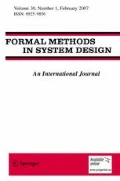Abstract
The purpose of this paper is to illustrate and compare some of the existing synthesis methods for discrete event controllers. We summarize four of the well-known methodologies in the context of plant model, specification model, and controller synthesis procedure. Then, by applying the models to two working examples, we explore and compare the descriptive power of the methods and their capabilities for handling various types of specifications.
Similar content being viewed by others
References
T. Boucher, Computer Automation in Manufacturing, Chapman and Hall, London, pp. 359–368, 1996.
E.M. Clarke, E.A. Emerson, and A.P. Sistla, “Automatic verification of finite state concurrent systems using temporal logic,” ACM Transactions on Programming Languages and Systems, Vol. 8,No. 2, pp. 244–263, April 1986.
A. Galton, editor, Temporal Logics and their Applications, Academic Press, 1987.
H.J. Genrich and G. Thieler-Mevissen, The Calculus of Facts, Lecture Notes in Computer Science, Vol. 45, Springer, 1976, pp. 588–595.
A. Giua, “Petri Nets as Discrete Event Models for Supervisory Control,” Ph.D Thesis. Dept. of Computer and Systems Engineering, Rensselaer Polytechnic Institute. Troy, N.Y., July 1992.
H.M. Hanisch and M. Rausch, “Synthesis of supervisory controllers based on a novel representation of condition/event systems,” IEEE International Conference on Systems Man and Cybernetics, Vancouver, British Columbia, Canada, Oct. 22–25, 1995.
H.-M. Hanisch, S. Kölbel, and M. Rausch, “A modular modelling, controller synthesis, and control code generation framework,” 13th IFAC World Congress, San Francisco, July 1996, Proceedings, Vol. J, 495–500.
L.E. Holloway and B.H. Krogh, “Synthesis of feedback control logic for a class of controlled Petri Nets,” IEEE Transactions on Automatic Control, Vol. 35,No. 5, May 1990.
M.D. Jeng, “Theory and Applications of Resource Control Petri Nets for Automated Manufacturing Systems,” Ph.D Thesis, Dept. of Computer and Systems Engineering, Rensselaer Polytechnic Institute. Troy, N.Y., 1992.
B.H. Krogh and Kowalewski, “Boolean condition/event systems: computational representation and algorithms,” Preprints IFAC 12th World Congress, Sydney, July 1993, pp. 327–330.
Z. Manna and A. Pnueli, The Temporal Logic of Reactive and Concurrent Systems, Springer-Verlag, 1992.
T. Murata, “Petri Nets: properties, analysis, and applications,” Proceedings of IEEE, Vol. 77, pp. 541–580, 1989.
J.S. Ostroff, “Synthesis of controllers for real-time discrete event systems,” IEEE Proceedings of the 28th Conference on Decision and Control, Tampa, Florida, Dec. 1989.
J.S. Ostroff, Temporal Logic for Real-Time Systems, Advanced Software Development Series. Research Studies Press Limited (distributed by John Wiley and Sons), England, 1989.
J.L. Peterson, Petri Net Theory and the Modeling of Systems, Prentice-Hall, Englewood, N.J., 1981.
C.A. Petri, “Communication with Automata,” Ph.D Dissertation, University of Bonn, Bonn, West Germany, 1962.
A. Pnueli, “Applications of temporal logic to the specification and verification of reactive systems,” in J. de Bekker, W.P. de Roever, and G. Rozenburg, editors, Current Trends in Concurrency, LNCS 244. Springer-Verlag, 1986.
P.J. Ramadge and W.M. Wonham, “Supervisory control of a class of discrete-event processes,” SIAM Journal of Control and Optimization, 25(1):206–230, Jan. 1987.
P.J. Ramadge and W.M. Wonham, “Modular feedback logic for discrete event systems,” SIAM Journal of Control and Optimization, 25(5):1202–1218, Sept. 1987.
M. Rausch, A. Lüder, and H.-M. Hanisch, “Combined synthesis of locking and sequential controllers,” International Workshop on Discrete Event Systems, Edinburgh, UK, August, 1996.
M. Rausch and H.M. Hanisch “Net condition/event systems with multiple condition outputs,” ETFA 95 Conference, Paris, France, Oct. 1995.
W. Reisig, Petri Nets, Springer-Verlag, Berlin, 1985.
N. Rescher and A.W. Roscoe, Temporal Logic, Springer-Verlag, Library of Exact Philosophy, 1971.
R.S. Sreenivas and B.H. Krogh, “On Condition/Event Systems With Discrete State Realizations,” Discrete Event Dynamic Systems: Theory and Applications, 2(1):209–236, 1991.
R.S. Sreenivas and B.H. Krogh, “Petri Net based models for condition/event systems,” In Proceedings of 1991 American Control Conference, Boston, MA, Vol. 3, pp. 2899–2904, 1991.
W.M. Wonham, “A Control Theory for Discrete-Event Systems,” Advanced Computing Concepts and Techniques in Control Engineering, M.J. Denham and A.J. Laub (editors), Springer-Verlag, pp. 129–169, 1988.
K. Yamalidou, J. Moody, M. Lemmon, and P. Antsaklis, “Feedback control of Petri Nets based on place invariants,” Automatica, Vol. 32,No. 1, pp. 15–28, 1996.
M.C. Zhou and F. DiCesare, “Adaptive design of Petri Net controllers for error recovery in automated manufacturing systems,” IEEE Transactions on Systems Man and Cybernetics, Vol. 19, pp. 963–973.
Author information
Authors and Affiliations
Rights and permissions
About this article
Cite this article
Pinzon, L., Hanisch, HM., Jafari, M. et al. A Comparative Study of Synthesis Methods for Discrete Event Controllers. Formal Methods in System Design 15, 123–167 (1999). https://doi.org/10.1023/A:1008740917111
Issue Date:
DOI: https://doi.org/10.1023/A:1008740917111




